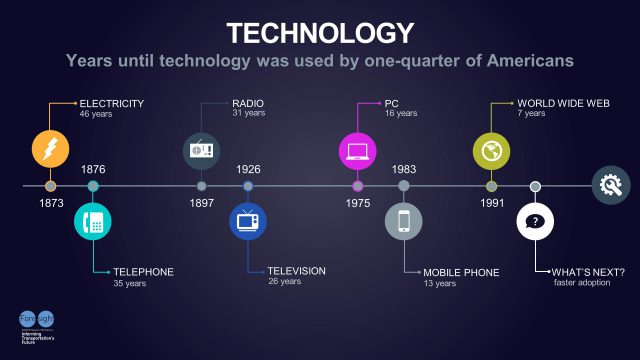I Love Transit 2018: the future of mobility—disruptions of yesterday, today and tomorrow
I Love Transit 2018: the future of mobility—disruptions of yesterday, today and tomorrow



It’s I Love Transit Week! A week where we celebrate our riders, transit enthusiasts and all the things we love about transit. Keeping the momentum of last year, this year’s theme is Connections—the future of transportation in Metro Vancouver.
Experts believe we’re on a cusp of a revolution in the way we move around, which they call “new mobility.” With that in mind, TransLink’s harnessing innovations in new mobility to create a more livable region. Eve Hou, who is TransLink’s project manager for new mobility, gives us the 411!
By Eve Hou, TransLink’s project manager for new mobility
If you are reading this blog, you’ve experienced disruptive innovation in your lifetime.
A disruptive innovation creates a market for a product that previously didn’t exist, and it ultimately (and often unexpectedly) overtakes existing markets. Think Netflix and how it created a new market for streaming media services, which previously didn’t exist, and led to people cancelling cable service.
Disruptions can happen in any sector of the economy – for example, agriculture, energy, telecommunications, and transportation. Interestingly, the pace of uptake of disruptive technologies is increasing, which means we will experience more disruptions than our parents did and our children will experience more than we did.

A look to the past
Arguably the last major disruption in the personal transportation market occurred in the early 1900s. In 1908, the Model T Ford was introduced. By 1925, almost half of American households owned a car, virtually eliminating the horse and carriage. Some factors contributing to the rise of the automobile included:
- Cost: Mass production made the automobile competitively priced with the horse and carriage;
- Convenience: Unlike a horse, which required a fair amount of care and prep (think feeding, housing, grooming, bridling, etc.), cars required very little in comparison;
- Safety: Automakers sold the promise of a ride that wouldn’t run away from you when spooked;
- No manure: At the turn of the last century, horse manure was a public health and environmental crisis. Cars solved this issue instantly.
Transportation disruptions of today
Today, we are (we believe) poised at the edge of another major disruption in personal mobility. Although the future is predictably unpredictable, analysts believe these four trends in the transportation sector are paving the way to some big disruptions down the road:
- Connectivity: The Internet of Things (IoT) is enabling vehicles and road infrastructure to interact. This has significant potential for efficiency improvements and more personalized mobility.
- Electrification: When the CEO of Shell started driving an electric car last year, even electric vehicle skeptics did a double-take. With lower operating costs, a smaller carbon footprint, and better performance than the gasoline equivalent, electric cars are poised to disrupt the internal combustion engine in the next few decades.
- Sharing: The sharing economy is a business model disruption which blossomed with the rise of the internet and smart phone. The sharing economy in the transportation realm has widened options for mobility, including car sharing, peer-to-peer car rental, peer-to-peer carpooling and ride-hailing.
- Automation: The car that drives itself is no longer a fantasy. Although still under development and testing, automation could significantly improve safety and convenience. These factors make automation potentially the most disruptive of the four trends.
Bigger disruptions on the horizon?
Although each of these four trends has disruptive power on its own, the combination of these four disruptions is game-changing. Enter the Automated, Connected, Electric and Shared vehicle, or ACES. ACES combines both technological innovations with a business model innovation to create a product which, at scale, has the potential to compete with the personal automobile on both cost and convenience, for a wide range of trips. For many automakers and tech firms, R&D into autonomous vehicles is a stepping stone towards the ultimate goal of bringing ACES to market.
However, there are many unanswered questions about ACES – technical and legal barriers are significant, but what is most uncertain is consumer response.
The disruption that binds them all
A fifth disruption a business model disruption that affects the very way consumers view mobility. This is the concept of mobility as a service (MaaS). The idea behind MaaS is that consumers in the near-future will buy trips, rather than vehicles. This is analogous to buying milk when you want it, in the quality and quantity that you prefer, instead of buying a cow.
MaaS uses smartphone technology and a backend platform to integrate trip segments from a whole host of providers, both public and private. Through a single app, users can plan, book, and pay for a journey that may include segments on transit, ferry, ACES, car share, e-bike share, taxi and rental car. Users can pay per trip or subscribe to a monthly mobility package. All payments and ticketing are via the app, rather than to each individual transportation provider, resulting in a seamless journey.
A number of companies are working towards the development of a MaaS platform, or components of a MaaS product, and a few have even launched, mostly in Europe.
TransLink Tomorrow
With this wave of change hitting the shores of Metro Vancouver, the Mayor’s Council 10-Year Vision gave TransLink a clear directive to explore and leverage new innovation.
As part of TransLink Tomorrow, we are engaging with the private sector on new ideas, demonstrating and piloting some of these innovations in our system, supporting the academic community to analyze their impacts and implications, and establishing plans and policies to shape the implementation of new forms of mobility to meet the region’s goals.
This past summer, we launched our first open innovation call, a chance for individuals, companies, non-profits, non-governmental organizations and academic institutions to partner with TransLink on new mobility initiatives. We’re also providing grants up to $50,000 for post-secondary researchers to explore new mobility issues and solutions.
By being proactive, we aim to harness these disruptive innovations to the benefit of all in the region.






Joe here.
Let me start by saying I appreciate bus drivers. Bus drivers got the second most underappreciated job in public transit – after the maintenance folks.
That said, you guys at TransLink think about automated buses? You’re about to get electric buses… which is a major step in that direction.
Thanks!
Hi Joe, thanks for your comment. Eve talks a bit about automation in her post. That’s all part of the ‘new mobility’ future we’re preparing for.